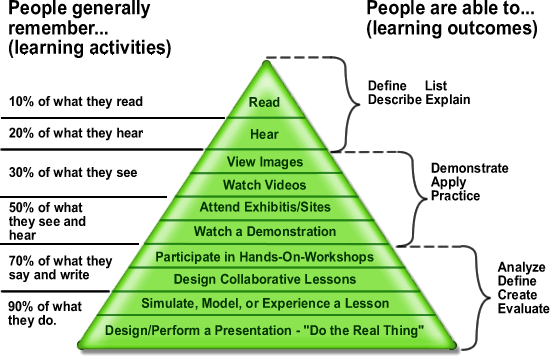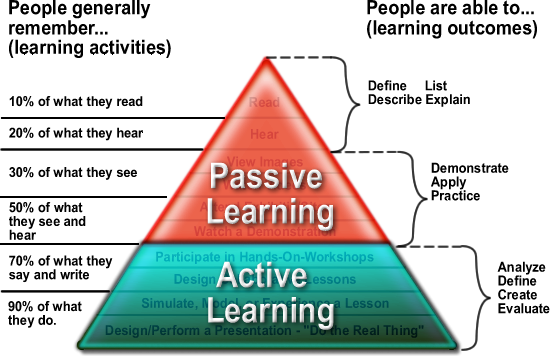Edgar Dale’s Cone of Experience
Whilst working on some other projects at school, I wanted to finally post this to a searchable resource that instructors and other educators can use. This is a combination of my most two recent posts at my own website at Edutechnorama…
September 24 2007: I just learned of some major news that is right under our feet at ASU: A potential competitor to secondlife developed by everyone’s favorite non-evil company, Google:
I would classify this as more of breaking news, but also an opportunity for educational technologists who lament about teaching in a virtual environment that is yet to become devoid of unruly behavior. I’m referring to secondlife and its variants who propose themselves to be the next best thing to the real thing. I’m one to accept most forms of technology in its usage for education, but in my opinion the best place to learn things of a lasting nature IS real life. I know…, big shocker. I get the feeling that many of my co-workers and colleagues would disagree.
Can you learn things in a virtual 3D world? Of course you can. If given a choice of how you want to learn your favorite subject, what environment would you choose? I’m going to refer to a favorite resource of mine called Edgar Dale’s cone of experience/learning. Much like the food pyramid explains which types of food are best for our bodies, this model (if you buy into it as much as I do) explains what is best for our learning experience.
Today’s food pyramid is somewhat different than ones of yesteryear. Whereas before, the food pyramid would list the most important foods at the bottom of the pyramid and further on up the ones that are not as important but still part of ones diet, the American government has now given us a new pyramid that is more in-depth and helps us make better choices about the important foods we eat.
If we transition this metaphor to the types of learning activities we choose for ourselves and others, we ought to give serious thought to the types of activities that will help us (ourselves, and our students) remember, retain, and grow as a result.
I would put virtual worlds in a category almost by themselves. While they are useful for lots of learning activities, I strongly advocate that we look for the real deal whenever possible. Learning space impossibilities such as dangerous conditions and training scenarios aside, the things that we remember most have to do with attention given to it in the first place. Often we don’t have the proper attention because our motivation isn’t there to begin with. Often our motivation is driven by some rooted emotional bias. As my Ed Psych professor from last semester quoted: “Emotion drives attention, which drives learning.”
I’d like to rephrase it into something a little more mnemonic:
Emotion drives attention which drives retention
By the way, I aim to render a really nice version of Edgar Dale’s cone of learning model using Fireworks soon. Hopefully google images will be able to pick it up in their indexing, because I’m going to be releasing it under the creative commons license.
October 9, 2007: And here it is in all its glory:

Here’s a version with some overlays to indicate those learning activities that are active and passive:

Active learning would include those activities that charge our brains and capacities to remember what we are experiencing. Passive learning would include those activities that people can still learn from, but not generally as effective as active learning.
Given this, we should realize that every human being is different. We as instructors and educators should be flexible to adapt to every person’s learning style and seek out their needs
As stated, I’m releasing this under a Creative Commons License under a variety of animated media presentation formats:
- MS PowerPoint (version 2003 or greater) Cone of Experience Media PowerPoint
- Adobe Captivate (version 1 or later) Cone of Experience Media Captivate
- Adobe Flash (version 8 or greater) Cone of Learning (Adobe Flash)
- Adobe Fireworks as an unflattened PNG file (still images only) Cone of Learning (Adobe Fireworks PNG)
Here’s the link to download them all as a zipped archive: Cone of Experience Media
As mentioned, anyone can use this stuff to their heart’s content as per the creative commons license below:

Edgar Dale Cone of Experience Media by Jeffrey Anderson is licensed under a Creative Commons Attribution-Share Alike 3.0 United States License.
Based on a work at www.edutechie.ws
